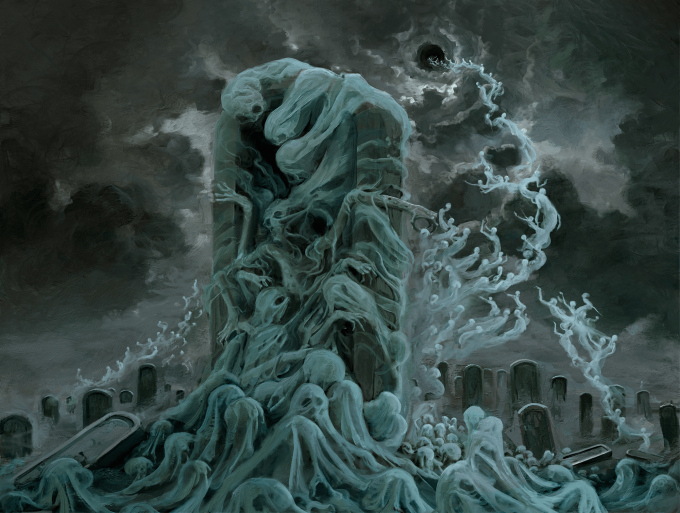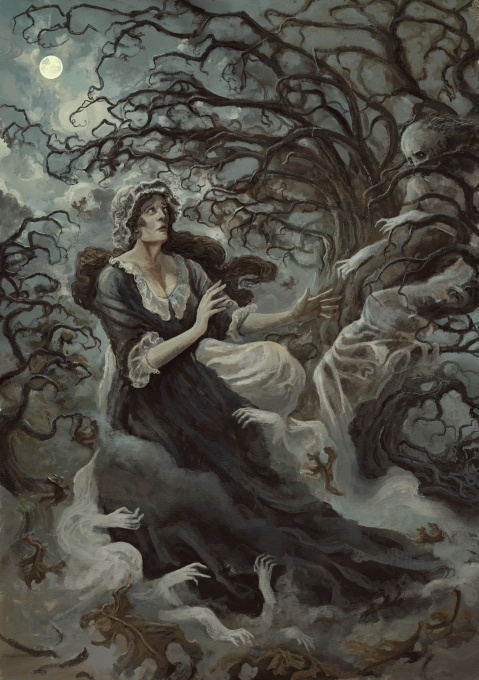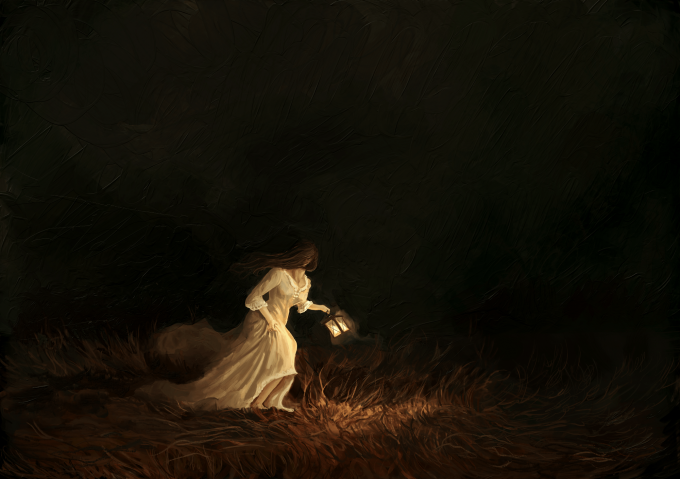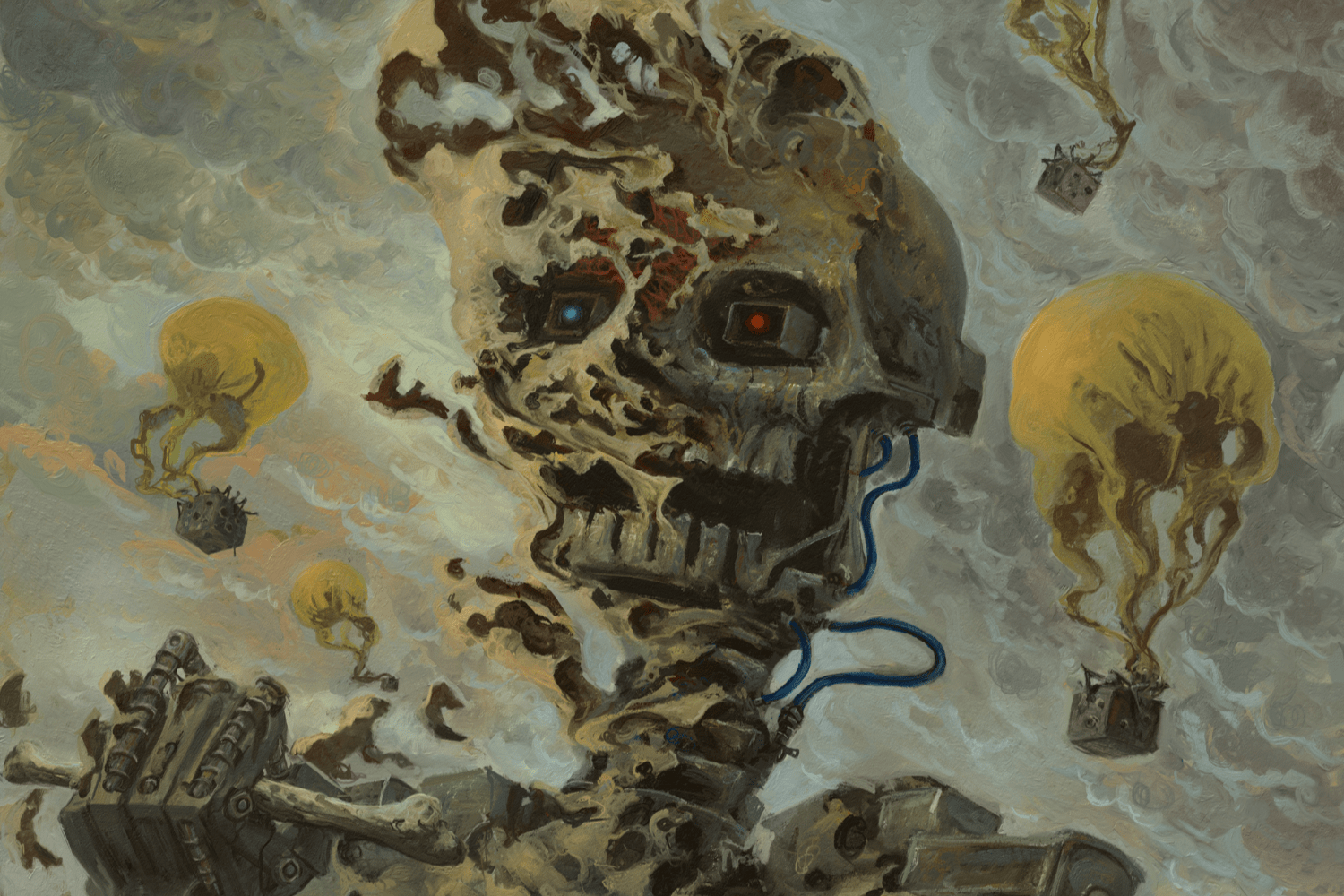We are always excited to get to know new talented artists through art contests and challenges. The Halloween Artist Contest connected us with Sandeep Karunakaran, with whom we have been in touch since. Today, we are pleased to introduce him and his work to all of you. Read an interview below to find out how his passion for sci-fi and horror developed into an artistic path.
Most of your artwork is horror or science-fiction themed. What sparked this style and led you to develop it?
First of all, thank you for having me for the interview. It is quite an honor to be interviewed for the Escape Motions blog.
Since I was little, I had an intense predilection for horror and science fiction subjects. I had an avid interest in paintings, animations, comics, story writing, and watching movies and documentaries. I guess this has played a significant role in developing an aesthetic sense of the genre. I believe my inspiration for most of my artworks today, arose mainly from these childhood nostalgias, and also from the imprints of crazy dreams and nightmares that I had when I was young.
 I believe in the concept that my paintings should create a dark atmospheric mood and that they should give a compelling feel to the viewers. I don’t have a proper definition for my style, but I could enunciate that my style is a mix of realism and surrealism, with some dark horror and nightmarish elements added to make it more believable and enjoyable. I always try my best to implement these methods in my paintings when I work for a client.
I believe in the concept that my paintings should create a dark atmospheric mood and that they should give a compelling feel to the viewers. I don’t have a proper definition for my style, but I could enunciate that my style is a mix of realism and surrealism, with some dark horror and nightmarish elements added to make it more believable and enjoyable. I always try my best to implement these methods in my paintings when I work for a client.
As I am also an ardent lover of old classic paintings, you can see these influences too in most of the works. I could also delineate my work as a contradictory form of art between nostalgia and what is to come in the future. In simple words ‘A retro-futuristic horror/Sci-Fi art’.
Being a freelance artist for a few years now, you have worked on many interesting projects. As the world went through a couple of rough years and many artists are on a hunt for new opportunities, do you have any advice for them on how to become successful freelancers?
When I first started as a freelance artist, I naturally had some tough times finding the right clients. It is not an easy job to be a freelancer, but I have been freelancing for over 14 years now. And there were certain times I had to work for clients without even receiving any payment, and also had to sell some exclusive licenses of my works as so.
From my experience, I would say that being a Freelancer has lots of limitations. You have to be aware of the fact that it is not like a regular job, especially when it comes to working and getting paid through the internet. It all depends upon our clients. Don’t expect magic to happen in a day, it takes time. Patience is most important to become a successful freelancer.
 There are many art communities out there to showcase your works. Make use of these platforms. These communities will help you to reach the right people and clients with your work. Sometimes social media like Facebook or Instagram can also support you in a similar manner.
There are many art communities out there to showcase your works. Make use of these platforms. These communities will help you to reach the right people and clients with your work. Sometimes social media like Facebook or Instagram can also support you in a similar manner.
Once you make your mark, you’ll have a wide range of opportunities opened for you as a freelancer.
You were born and raised in India. Would you say self-taught and art school-raised artists in India have the same opportunities to succeed as those from Europe or North America? If not, what needs to change?
I believe that in India, art school-raised artists have much better opportunities compared to self-taught artists. It is because the Indian art and entertainment industry is more entrusted to these professionally trained, and considers them more reliable rather than compared with self-taught talents. I cannot blame them because they are bound or constrained from taking any chances outside of their decree.
But the ultimate fact is that when analogized to other professional and non-professional occupations, being an artist is broadly often considered an undervalued profession. Such an attitude suppresses creative endeavors and many of the talents are disposed to be unseen. If this is the case of professionally trained, you can imagine the position of self-taught? These attitudes need to be changed. I wish to see artists considered a secure profession.
 While in America or Europe, the industry has a more progressive approach to the system. Whether professionally trained or not, artists have a wide range of possibilities and opportunities opened for them to thrive and have successful careers.
While in America or Europe, the industry has a more progressive approach to the system. Whether professionally trained or not, artists have a wide range of possibilities and opportunities opened for them to thrive and have successful careers.
So relatively speaking, being an artist in India has much less chance to succeed than those from Europe and North America. But I have to admit that these things are changing now. There has been drastic progress in India just within the last ten years
The growth in the economy is mirrored by equal progress to be visible in the creative industry and the arts. I can see that a lot of job opportunities have been opened up and these will provide the ‘ door steps’ into this field so we can be part of the global creative industry. People who work in 3D graphics, visual effects development, and such like, have now started to become an integral part of Hollywood and the global entertainment Industry. It is surely something that I never thought would attain in a short period!
Walk us through your work process.
I could never seem to find any meaning to the nightmares and visions I previously mentioned, so I try my best to capture them, modify them, and use them as a foundation for my paintings. Sometimes, I try to dig out the ideas from the dark niches of my mind. It may sound strange but it does work for me. I have done many paintings in this manner.
My other sources of inspiration are mainly classical paintings. Modern surreal masters like Beksinki and H.R. Giger are also constant sources of my inspiration. I always try my best to deliver these moods to most of my work.
 When these ideas pop up, I immediately start the process by laying out the essential colours and shapes first as the base for the painting. For this, I use a 4000-pixel canvas that is set to 300 DPI (standard dimensions I use when working with Rebelle ).
When these ideas pop up, I immediately start the process by laying out the essential colours and shapes first as the base for the painting. For this, I use a 4000-pixel canvas that is set to 300 DPI (standard dimensions I use when working with Rebelle ).
Once I get the overall impression of what I am going to achieve and am satisfied with the basic composition, I set to work on details by pulling out the shapes and structures. I normally don’t begin a painting from a sketch, instead, I just work with blocks and shapes, then gradually add details to build up the form. Being a digital artist I have much more control over these processes than working with the traditional medium. It is a bit tedious and time-consuming process, but I am used to the habit of working this way. I feel like I have more control over the painting.
I generally work at a slow pace. It can take up to fifteen days or more to complete a painting, depending on the complexity of the work. Even though I am working with digital tools, I like to approach the work in a traditional fashion.
As for digital tools, I switch between Photoshop and Rebelle for finalizing a painting. As Rebelle gives me a more naturalistic traditional feel to the final output, I turned out to use Rebelle as my primary software.
It is no secret you have won our latest Halloween artwork contest and received a Xencelabs tablet among other prizes. Have you had a chance to use it? What are your thoughts?
After reading the first couple of reviews, I was skeptical about these tablets. I was wondering whether Xencelabs lives up to the hype compared to other professional tablets in the Industry. I was eyeing the Xencelabs tablet for a while. When I won the Halloween contest, it was like my wish came true.
 When I got the chance to use it, I was kind of flabbergasted by its quality and performance.
When I got the chance to use it, I was kind of flabbergasted by its quality and performance.
I found it very lightweight and portable to use. The overall design and connectivity features looked excellent. Above all, I felt the device is very comfortable, delivering a paper-like natural drawing experience, and the output was simply astounding. The pressure sensitivity, latency, and pen precision are just incredible. Without a doubt, it did live up to the hype and indeed a portable professional tool every artist would crave for.
Xencelabs tablet has a discernible advantage when used with Rebelle 6. It brings out the texture on the canvas like actually painting on a traditional medium. Rebelle’s new Xencelabs tablet selection option brings out the best of the tablet. All I could say Xencelabs and Rebelle 6 are a winning combination.
I am looking forward to seeing what Xencelabs will come up with in the future.
Since the contest, you have added quite a few Rebelle artworks to your Community portfolio. How did you find out about our software and what part does it play in your creative process? Do you have a favorite feature?
The word about Rebelle has been buzzing around here and there on the internet for years. If I remember I first discovered Rebelle when it gained popularity as the best watercolor simulation software. But at that time I was more looking for oil painting simulations. When Rebelle started to spread its wings to other traditional mediums, I got more and more attracted to the software. The introduction of NanoPixel technology, realistic oils, and traditional pigment color mixing features was a killer breakthrough, especially for digital artists seeking to give a hyper-realistic feel to various traditional mediums in their paintings.
I love all the new features of the Rebelle 6 Pro. But in general, my favorites include NanoPixel export, traditional pigment color mixing, and the new fractal image processing for transformation and deformation tools.
 Most of the recent artworks in my Community portfolio are fully done in Rebelle. I use Rebelle as my primary digital painting software for all of my paintings today. So It doesn't play the partial role anymore, rather Rebelle is what I work with.
Most of the recent artworks in my Community portfolio are fully done in Rebelle. I use Rebelle as my primary digital painting software for all of my paintings today. So It doesn't play the partial role anymore, rather Rebelle is what I work with.
Since it is the period of AI-generated painting, all digital artists including myself, are in a state of predicament competing with these AI talents. But, I don’t think that AI is capable enough of achieving that traditional feel that human hands could possibly accomplish, no matter how realistic the output is. This is where Rebelle has the upper hand, and advantage by aiding digital artists to deliver that same classical touch to their paintings, which will separate them from AI-generated artworks. So Rebelle can walk tall with prominence and uniqueness.
What are some projects you are currently working on and where would you like to see yourself as an artist in 5-10 years?
Recently, I have done commissions for a single music cover and an album cover art for an indie music band.
Presently, I am working on some personal projects that have a science fiction flavor. The concept has been on my mind for a while now, but I guess it’s about time to pour it out into the canvas.
 It is a very difficult question to answer, but I would like to see myself evolving into a better and more solid artist than I am today. I tend to switch between the ‘styles’ and explore various facets of it. For example, you can see me handling both surreal and realistic styles in my paintings. I use both techniques to express my concepts. I believe that this has affected me as an artist to a certain extent. So maybe in 5-10 years, I may find a solution to get it done in a better way. And it is where an artist can claim that he has reached his perfection. I am working on this.
It is a very difficult question to answer, but I would like to see myself evolving into a better and more solid artist than I am today. I tend to switch between the ‘styles’ and explore various facets of it. For example, you can see me handling both surreal and realistic styles in my paintings. I use both techniques to express my concepts. I believe that this has affected me as an artist to a certain extent. So maybe in 5-10 years, I may find a solution to get it done in a better way. And it is where an artist can claim that he has reached his perfection. I am working on this.
Sandeep, thank you for your time, introduction, and honesty. It was a pleasure getting to know you and your work more. We wish you many creative days with Rebelle!
Escape Motions Team
----
Learn more about Sandeep Karunakaran:
https://www.escapemotions.com/community/user/sanskarans/portfolio/
https://sanskarans.blogspot.com/
https://www.deviantart.com/sanskarans
https://www.artstation.com/sanskarans



